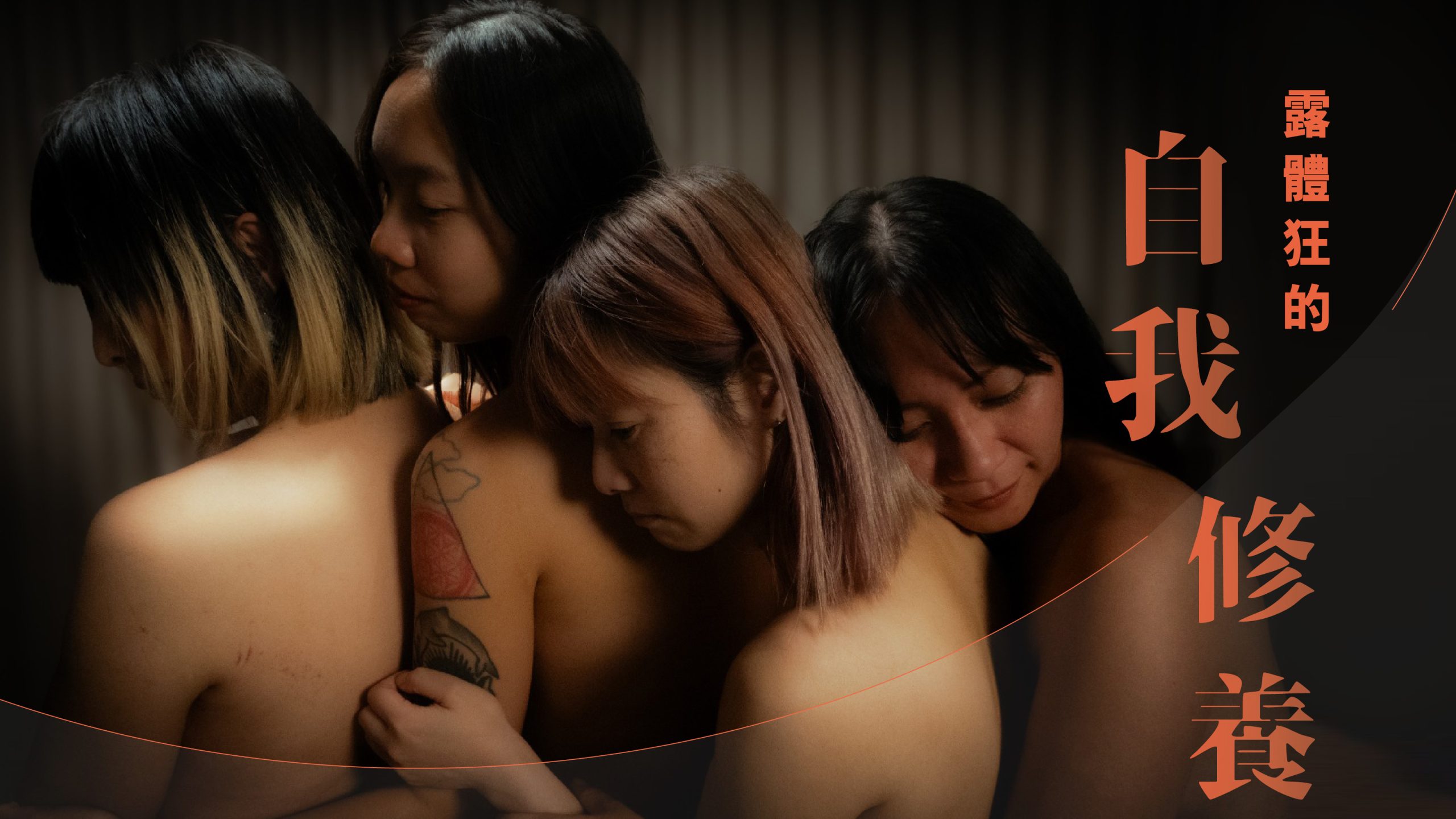Watch on YouTube:https://youtu.be/_ki23G4rPos
人們說你要離開這陣營,我們無不覺得吃驚
《露體狂小丁》— Forever Tarkovsky Club
因為這不是你的個性,你生來是露體狂小丁
The Bare Utopia
“I am not inherently drawn to nudity,” Siu Ding admits with a hint of shyness. “To wear or not to wear, I see it as a choice of freedom and a state of being.”
The duo Ho Shan and Ah P form the band “Forever Tarkovsky Club” (永遠懷念塔可夫斯基) notable for their song 《露體狂小丁》. In reality, Ding is a seasoned life model., reflects on the humour and positivity she has brought to the term “exhibitionist” (露體狂), once used in jest by friends. “It’s about redefining a concept from a negative connotation to a positive light,” she shares.
Would a world without the need for clothes be ideal? “The perfect state,” Siu Ding says, “would be where people on the streets could choose to wear or not, and everyone respects each other. That, to me, is freedom.”
The year 2023 sees the profession of life modelling no longer a novelty. Viewing it with prejudice now seems archaic. Having modelled for over a decade, Siu Ding finds it odd that the interview’s questions haven’t evolved over time. Friends often remark that Siu Ding’s modelling seems natural given her beautiful, confident body. In 2017, grappling with health issues and facing mortality, Siu Ding founded the Hong Kong Life Model Club, “I have only one body and wanted to understand others.” This led to the “Body Fest”, a nude art-themed exhibition, the book Our Models, and a photo exhibition in collaboration with the Hong Kong International Photo Festival (HKIPF), giving different bodies a chance to tell their stories.
Life models, unlike traditional fashion models, aren’t defined by typical “standard figures”. They allow diverse body types to showcase every curve and flaw. While fashion models are often directed by photographers, life models advocate body autonomy. They can adjust the environment to their needs, even refuse inappropriate requests. Each artwork’s release requires the model’s consent, a form of respect. Many artists seek to represent various body shapes, and life models provide inspiration and new trials, fostering a two-way communication.

Your naked body should only belong to those who fall in love with your naked soul.
Charlie Chaplin
Nude.Drink.Draw
Here’s a little story.
In his first life drawing workshop, the session lasted about an hour. Afterwards, the instructor asked how much time was spent observing the model versus looking at the paper. Most replied it was about half and half. “Why not focus more on the model?” the instructor queried.


This prompted a realisation: rather than striving for a result, it’s about understanding, observing, focusing. He prefers “blind drawing”, initially focusing on the model to capture subtle curves. He loves drawing people, as they are alive, breathing, emotive, and ever-changing. To him, drawing is not just about the artwork but understanding a person. In the workshop’s last 20 minutes, he tries to capture the model’s pose, the skin’s colour variations. Beyond mere flesh tones, there are veins, bones, tissues adding depth and hues. While clothes and accessories may go out of fashion, the purity and truth of the naked form hold a unique allure that keeps him drawing.

Sing, founder of NuDD Studio, was inspired by a similar place in New York, where people drew, drank, and conversed leisurely. The models there were performance artists, circus performers, and eccentrics, creating a fascinating environment. Bringing this “personal” interest to connect people, NuDD Studio was born in To Kwa Wan, offering regular life drawing workshops. Its full name stands for Nude, Drink, Draw.
Voices of the Bodies
A magical evening unfolded at NuDD.
Four life models, including Siu Ding, gathered. Some knew each other, some were strangers. Photographer Linda was capturing the interview for an upcoming documentary on the Hong Kong Life Model Club. As Siu Ding says, the club finally lets other bodies speak. The night included a transgender individual, a veteran, and the mother, bodies and stories of all kinds.

Body Story of Jane
How does an ordinary girl find her way into life modelling? “I did it for money,” Jane admits, slightly embarrassed. Siu Ding quickly interjects, asserting that working for financial reasons is perfectly normal and not to be seen as nefarious. Initially, Jane was simply looking for a part-time job. However, she entered this world carrying the heavy trauma of sexual violence experienced in the underground music scene. “I have no rejection towards any part of my body, it’s my life as a whole that I struggled to accept.” After six years as a life model, Jane spent a similar duration overcoming these painful memories. “Being a life model never made me feel ashamed, but I felt ashamed of my life.”
It was only after two or three years of modelling that she realised a part of her life was healed through life drawing. “In the drawing sessions, artists surrounded me with respect, communicating in a manner that honoured my body. They would draw me without ever touching, taking care of all my needs, even fearing I might get cold.” In this mutually respectful environment, there was no judgement of her life or body. Watching the artists capture her form filled her with a sense of worth. “A part of my life was healed through life drawing, a healing I call ‘being seen’. I thank all the artists who have drawn me, for they showed me that I need not feel shame for simply existing.” Jane’s journey has been one of reconciling with her past.
Body Story of Serene
After giving birth, Serene looked at her body, with its stretch marks and altered nipples, feeling half like herself and half like a stranger. She reached out to Ding with a desire to become a life model, to rediscover and document her body’s unique changes. Initially fearful of others’ gazes, her courage grew with each session. “Seeing how the artists depicted me, I realised all my perceived flaws were worthy of reevaluation and acceptance from different perspectives.” Serene, with a tall and slender figure envied by mainstream society, had not accepted her own appearance before becoming a model. “I had many critical thoughts about my body, like dissatisfaction with my breasts.” Only as a model did she learn to gracefully accept and document her body, a part of her healing journey. “Everyone’s growth process or inherent factors shape their unique bodies. Being such a part of myself, there’s no need for comparison.” She even showed her daughter the stretch marks on her belly – a badge of honour and a bond with her child.
Body Story of Jo
“My situation is somewhat different from the others,” says Jo, a transgender individual. The male characteristics of her birth sex were a source of disgust, but life modelling helped her see these features as unique traits to be boldly displayed and appreciated. “After surgery, there’s not much difference between me and a cisgender female. Therefore, the private parts or sexual characteristics are exactly what I want to showcase.” Her first public modelling experience was in June last year, at a queer life drawing workshop co-organized by Eaton Hotel and the Hong Kong Life Model Club. “With this event, I wanted to convey to others like me that you don’t need to hide. You should show the unique aspects of yourself to the world.”

Still the Exhibitionist, Siu Ding
How does nudity find its place and value in the art of modern society? Siu Ding, a passionate enthusiast of the human form, loves photographing bodies, her own and others’, and even aims to create a space where all bodies can come together. Nudity doesn’t have to hide in the shadows or corners of the city. Siu Ding hopes that one day, the public will have more choices than just clothing. Last month, we were invited to Siu Ding’s photography exhibition on Shibari, exploring yet another story about the relationship between the body and space.
Photo source: BBOLD、NuDD

